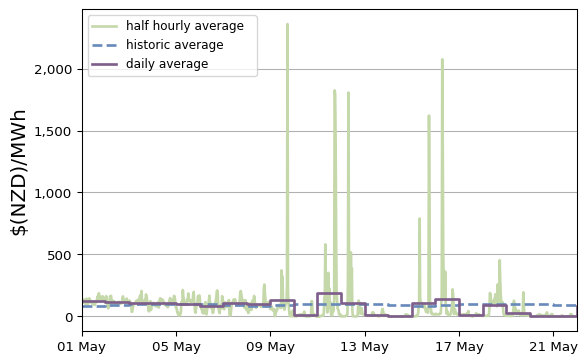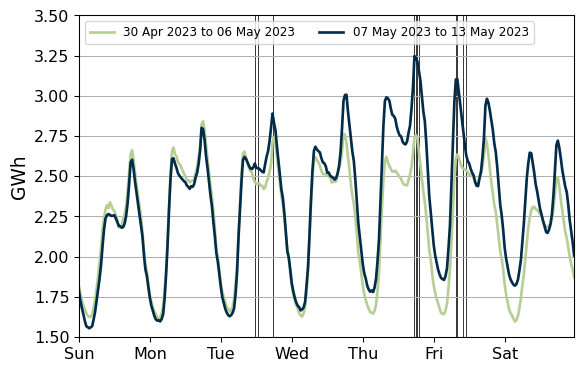Eye on electricity
Spot market price volatility in May 2023
- Wholesale
- Prices
In May 2023, the electricity spot market experienced extreme price volatility1. Spot prices swung between $0.01 and $3,350/MWh. However, despite occasionally high half hourly prices, the average2 price was $81/MWh.
Figure 1 shows the nationally averaged, half hourly, daily and historic3 spot prices between 1-22 May 2023. While daily average spot prices hovered close to the historic average, half hourly price spikes above $1,000/MWh occurred six times between 1-22 May.
These extreme swings constitute a shift in price dynamics from April 2023, when prices were less volatile, but the average price was similar at $89/MWh. So, what caused this change?

Between 1-22 May 2023, national hydro storage increased by 650 GWh (or from 83% to 96% of full), reaching its highest level since December 2019. Some hydro lakes went above allowed levels, causing water to be spilled. As a result, hydro generation increased from 66% of total weekly generation in late April 2023, to 72% between 14-20 May 2023. This, paired with times of high wind generation and low off-peak demand (mid-morning - late afternoon and overnight), has resulted in some extremely low prices – as nearly all the electricity demand could be met with cheap renewable electricity sources.
With winter approaching, however, peak demand is increasing. Figure 2 shows the weekly national demand profiles for two weeks in May 2023. Peak demand increased between 7-13 May, compared to 30 April-6 May, with many price spikes occurring during peak demand times. So, to ensure peak demand is met, additional thermal generation must run - sometimes for short durations. This can cause price spikes for several reasons.

Thermal generators adapt to expectations of runtime - as it impacts their operating costs
Firstly, forecasting anything is tricky, and under and over forecasting is inevitable – as often happens in weather forecasts. In May 2023 there were instances of under-forecast demand and spot prices. Demand and price forecasts are produced by the system operator leading up to each half-hourly trading period. These forecasts signal to generators whether their units are required to meet expected demand - and the likely spot price they will receive if they do run.
If forecast prices are low, this signals some generators may not be needed in that half-hourly trading period. Thermal generators may then price their units high, as they aren’t expecting to run.
This high price reflects increased operating costs of running for only a short time. So, if demand is unexpectedly high, wind generation dips, or other generation fails these high-priced thermal generators may get dispatched, resulting in a high spot price.
Additionally, several thermal units need multiple hours to start up. These are usually referred to as ‘slow-start’ thermal generators. Price signals which accurately reflect final prices, ahead of time, enable these generators to make informed start-up decisions. If the forecast prices are below a ‘slow start’ thermal generator’s expected operating costs, they may not be offered into the market.
Low wind generation, transmission constraints and reserves scarcity have also contributed to some high spot prices
This problem of under forecasting is exacerbated when wind generation is low, as there is less ‘wiggle room’ in the system for forecasting errors. Low wind generation and inaccuracies in forecasting was a contributing factor for the May spot price spikes.
Instances of reserve scarcity contributed to some high spot prices in May 2023. Here a special type of electricity spot market pricing applies, see First instances of reserve scarcity pricing under real-time pricing.
Additionally, at times demand couldn’t be met with cheaper electricity due to constraints on power lines.
Spot price volatility will continue as New Zealand transitions to a highly renewable power system
Wholesale electricity price volatility is expected to persist as New Zealand transitions towards 100% renewable electricity generation. Periods with abundant water, wind and sunshine will see extended periods of low electricity prices. Then if renewable sources of electricity aren’t enough, thermal generation (which may potentially become green peakers1 in the future), large scale batteries, or demand response will cover the difference, which could cause spot prices to spike.
Households and small businesses are protected from price volatility by paying a fixed cost for electricity. Industry participants can use the ‘hedge’ market to manage their exposure to electricity spot prices.
Steps we are taking to address spot market changes
The Electricity Authority has responded to emerging changes in the electricity market. Spot price sensitivities to changes in demand are now published on the WITS website. The Electricity Authority will soon consult on ways to improve the forecasting accuracy of intermittent generation, like wind and solar. We intend to publish an issues and options paper on our website in June and look forward to your feedback.
As part of our monitoring of trading conduct, we are carrying out further analysis of some of the high prices that occurred in May 2023. Updates on our analysis can be found in our weekly trading conduct reports.
1. Electricity price volatility
2. Between 1-22 May 2023.
3. The historic average includes inflation adjusted prices between 1996–2022.
Related News
Additional consultation: Improving visibility of competition in the OTC contract market
We are undertaking additional consultation on our proposed clause 2.16 information notice to improve monitoring and transparency of the over-the-counter market.
Better tools to manage price volatility and incentivise flexible demand
This is the Authority’s latest quarterly update on how we are implementing the Market Development Advisory Group’s final report. It covers April to June 20…
Contract extension for commercial market making services
The Electricity Authority Te Mana Hiko has extended by eight months the end of the current contract to provide commercial market making services.